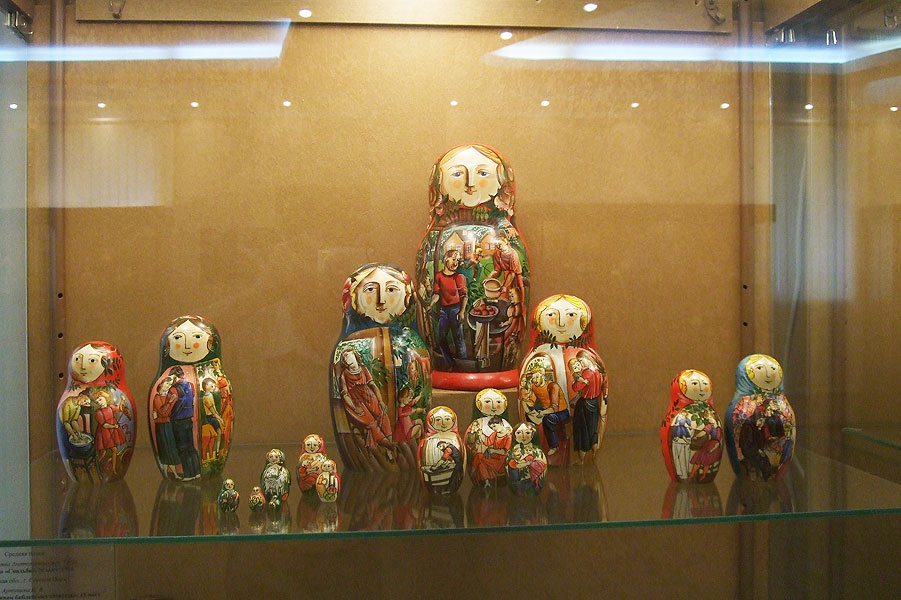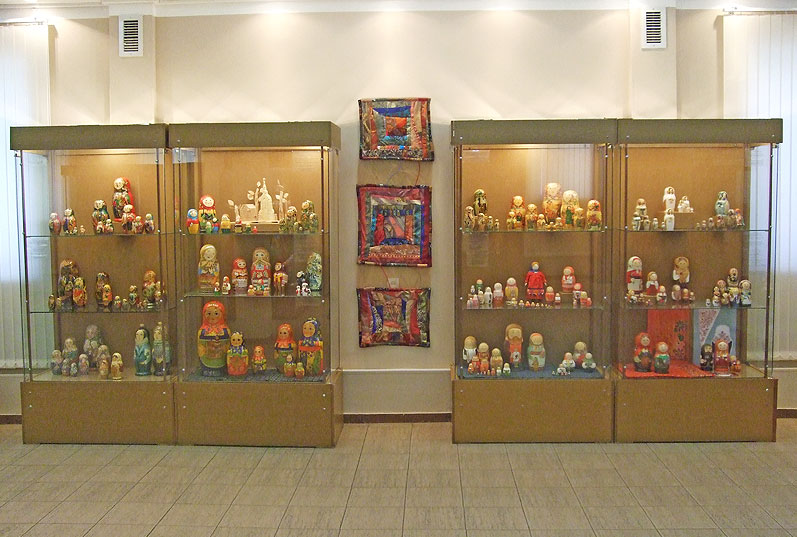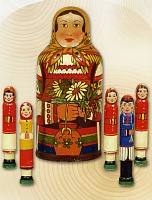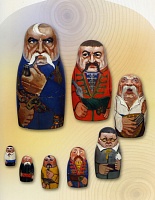6 october 2010 - 12 november 2021
Wednesday – Sunday 10 00 – 18.00
Ticket for 1 exhibition or exhibition:
- adult - 160 rubles.
- preferential - 80 rubles.
Photo and video shooting in the museum premises on the visitor's equipment (photo or video camera), without using a flash, tripod and monopod
- Photo - 170 rubles/person.
- Video - 230 rubles/person.
The exhibition “Museum of Russian Matryoshka”
The exhibition “Museum of Russian Matryoshka” presents a large group of items of the 20th - 21st century from the Sergiev Posad Museum and private collections. They illustrate retrospective stages of matryosha-doll development, stylistic and plastic processes in toy making that took place in the course of the last decade. There are works of professional artists and folk craftsmen from all traditional matryoshka centers situated in the Moscow, Nizhny Novgorod, Vyatka regions and specimens of such a bright contemporary phenomenon, as the “author’s” matryoshka.

A great success of the matryoshka-doll, gained over 110 years ago, does not fade away. Coming into the world the matryosha stroke the contemporaries with the artistic perfection of image and national character that, in time, made it not just a toy, but a memorable souvenir and symbol of Russia. The matryoshka appeared as the result of the romantic trend, determining the 19th century Russian art, as well as growing demand for didactical toys. At that time the Russian toy makers paid great attention to intellectual games. The turned nesting doll helped a kid to grasp easily difference of sizes, color, shape, quantity; it trained eye estimation, sense of space and composition.

There are no documents referring to the matryoshka’s origin. It was first found in the workshop “Children’s Upbringing” (1883 – 1918) belonging to Anatoly Ivanovich Mamontov (1839 – 1905) and his wife Maria Alexandrovna (1840 – 1904) on the eve of the World Art and Industry Exhibition organized in Paris in 1900. The doll was highly appreciated by the Exhibition visitors and awarded a bronze medal. The first 8-pieces matryoshka depicting “A Girl with a Rooster” is believed to be created by a brilliant artist representing the neo-Russian trend Sergei Vassilievich Malyutin (1859 – 1937) and a hereditary turner Vassily Petrovich Zvezdochkin (1876 – 1956) from Shubino village in Podolsk district of the Moscow province, who turned the shape (This matryoshka is located in the collection of Sergiev Posad's "Museum of Toys" ).

The matryosha needed the “second birth” in a major Russian toy center – Sergiev Posad, in the Moscow gubernia to become a commercial article of a symbolic character. In 1904, the Sergiev Posad toy studio, belonging to the Moscow provincial zemstvo, bought items of the “Children’s Upbringing” salon, including specimens of the nesting doll. The Sergiev Posad craftsmen used them as certain reference objects for subsequent creative variants and replications. Due to the mutual creative efforts of the professional artists, cooperating with the zemstvo studio, and folk craftsmen there appeared a great amount of matryoshkas of various shapes, content and painting methods. The “Russian style” prevailed in toy artistic features. The matryoshkas personified Old Russian boyars, epic and fabulous heroes, historical and literary characters. However, the matryoshka, looking like a peasant girl with some fowl or utensil, was still most popular among the customers. The emphasized decorativeness of commercial matryoshkas conveyed the national idea of beauty: a broad-faced, high-colored and notably plump woman attired in a festive costume and expensive floral-patterned kerchief and “containing” a big family inside.
Wide recognition in Russia and abroad made the matryoshka a basic commercial product in Sergiev Posad in the 20th and 21st centuries and promoted subsequent development of several centers. Among them are famous handicrafts in the Podolsk district, Moscow area; in the towns Semyonov and Gorodets and Polkhovsky Maidan village, Nizhny Novgorod area; the town Novlinsk and Lugovye village, Vyatka area. The ornamental and decorative matryoshka style in each center is characteristic. The Sergiev Posad matryoshkas are marked by well-balanced spherical forms with the relation of 1:2 between their width and height, conventional floral ornaments painted in gouach of bright contrasting colors (red,, yellow, blue and green) applied in vivid strokes of brush and outlined in black.
The Semyonov matryoshka is more slender: its thing upper part smoothly passes in the thicker bottom. The local turners are famous for many-pieces matryoshkas and container-dolls conventionally shaped like girls or a young men “in traditional costumes”. They are painted in aniline red, blue, green and violet outlined in black. The ornamental pattern of the traditional matryoshka contains bunches of large fancy flowers framed by buds, small flowers, berries and leaves. Women artists use free brush strokes to create compositions that are various in shapes and contours, but integral in rhythm.
The Vyatskaya matryoshka is easily recognizable by good-natured smiling face with large blue eyes, red hair and traditional dress painted in aniline colors. Its apron is adorned with bunches of large scarlet poppies and roses framed by leaves. The matryoshkas are often decorated with patterns of straw application work. The artists use the natural golden color that becomes pearly depending on the visual angle. The artists learned to color straw so that the patterns under lacquer coat looked like precious stones. The highly emotional image of Russian matryoshka is associated with festive mood and joy of existence; it symbolizes the integrity of the traditional world view.














